Kayaking Newark Slough
Newark Slough, what? Sounds like a sewage channel in New Jersey or something. No, it’s actually a pleasant little saltwater slough on the southeast San Francisco Bay. Here’s a Google Map snip: https://goo.gl/maps/U5LxJ
And here is the link to our track via the little InReach that goes along with us: https://share.delorme.com/gregilles
A “slough” in this context is an area where sea water flows in and out of a land area, under the influence of tides. It’s not an estuary (where a river flows to the sea), but simply a tidal flux area. As such, it can have currents and widely varying levels. These give rise to the flow of nutrients, and as a consequence it’s common to find wildlife concentrations in slough areas.
We decided to explore it in our kayak, and we launched yesterday (with a modest concern) into an ebbing tide. Our principal consideration was the current that we knew we’d have to fight on the way back “upstream”, and the possibility of the channel dropping so low that our kayak would run aground. It turned out there were other considerations as well.
Heading down-slough (toward the Bay), our first views were placid. The winds were light, currents slightly in our favor, and we were having a grand time being out “in the wild”.
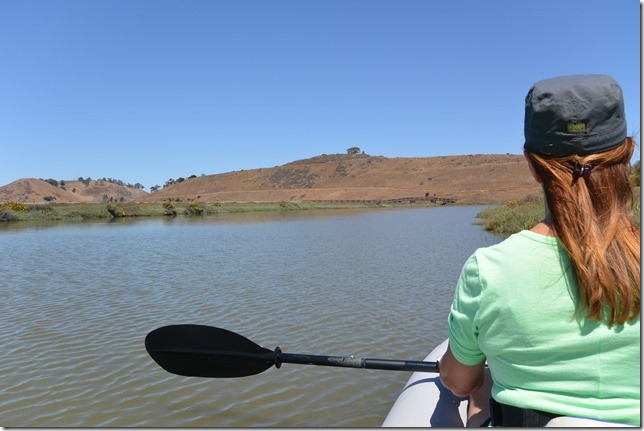
The slough goes through the Don Edwards wildlife refuge, and a nearby trail has some bridges, out-buildings and such.
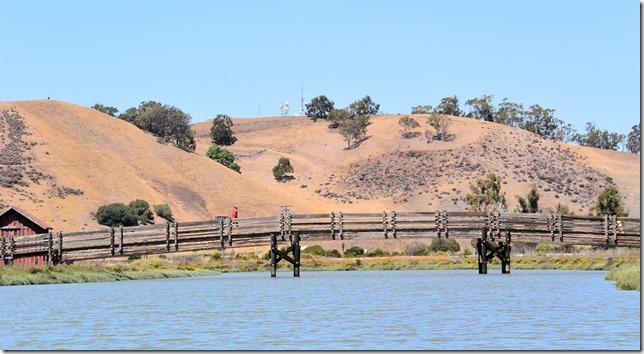
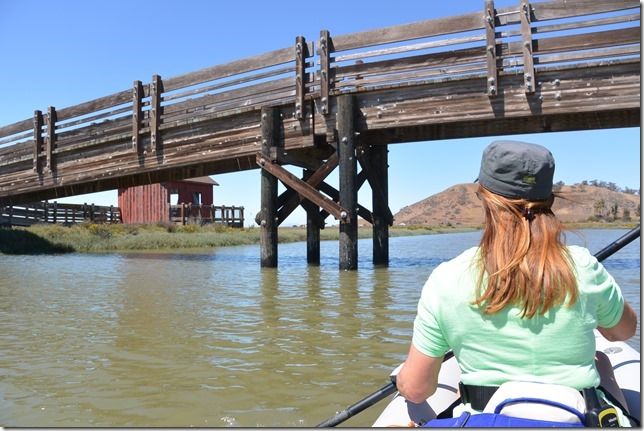
Rounding the northern end of the slough, the whizzing traffic on 84 drew a stark contrast to our green tranquility. We paddled on past and left the hurried commuters behind.
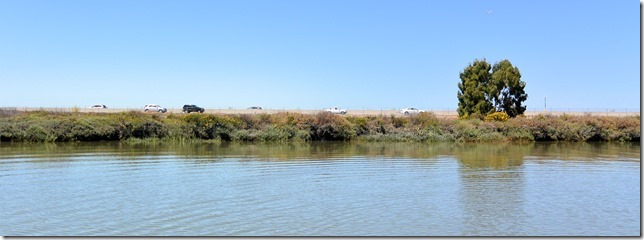
Various sights presented themselves as we paddled and drifted along. That time of day (early afternoon), wildlife was resting and not readily apparent. What’s the old saying? – – “Only mad dogs and Englishmen go out in the noon-day sun”. I suspect that hikers and bikers on the levee trails had a better view of shorebirds and what-not. The birds won’t raft up in the slough because of the constant shifting of the waters; salt ponds are still and much more roost-friendly.
Pieces of history, and present-day, hove into view as we went along our way – – –
A piece of dredging equipment that reminded us of Mississippi river boats.
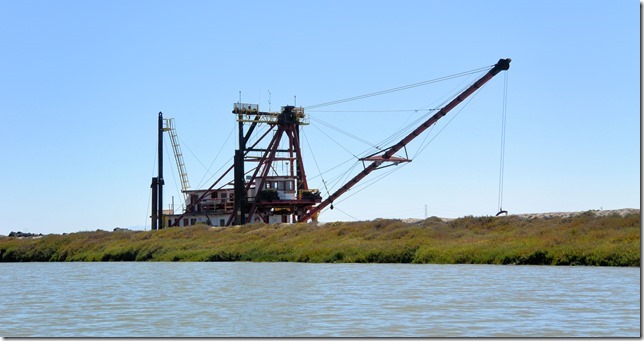
The Hetch-Hetchy water-pipeline crossing.
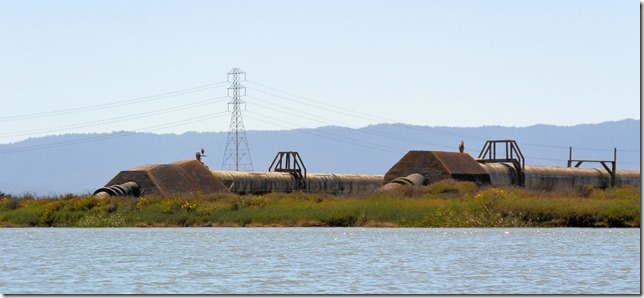
An old (out of service) swivel-bridge. They must have done a bang-up job maintaining the mechanism on that old bridge, because the massive drive gears were still slimed up with dense gear grease, and had not a patch of rust on them. Couldn’t say the same for the girders and such, which were rotting away under the salt-air onslaught.
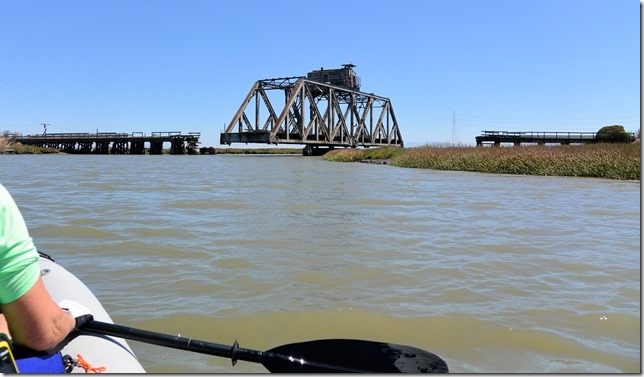
We paddled and relaxed, and had a snack or two, and finally made it to the mouth of the slough and our only view of the Bay for the day.
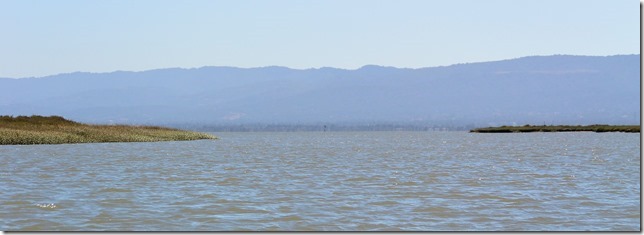
Then, it was time to head back to the car. At 3PM, the tidal flow was in full flux out-bound (against us), and adding to the challenge was the afternoon wind, seemingly always in our face. As soon as we turned around, the combined force of wind and tide slammed into us, and reduced our forward progress to that of a glacier.
Paddling like demons, we crossed the channel to try to get in the lee of the levy bank, and that ploy allowed us to move up-stream at about 1.5 knots, half our normal speed. But clinging to the bank also ran us through many shallow spots, and our kayak’s 6” keel-skeg would bog into the bottom mud, stopping us instantly. Using the paddles as push-poles sludged them up tremendously, and we’d lose precious yards sloshing them clean after we broke free from the bottom.
At every turn in the channel, we’d have to try and figure out the new wind angle, race across the furious energy of mid-channel, and “thread the needle” on the opposite side, between the mud and the wind/tide. Too far out in the channel – blown backwards. Too close to shore – grounded in the mud.
Thusly did we spend the next two and a half hours of virtually non-stop paddling, at around 80% max effort the entire way. Needless to say, we had some aching arms and shoulders by the time we got back to the car. But our challenges were not behind us yet.
When we arrived at the “boat ramp” (a very loosely-used term), it was no more than a gently sloping mud plain. The falling tide had left the firm upper section of the ramp far out of reach. Starting to get out of the kayak, my foot plunged into the mud – – and just kept on going. When the gooey stuff reached my knee, I realized that, even if I could stand (doubtful), I could never even walk, much less haul the kayak up out of the water. I pulled my leg back out, with great force, and a sound much like that of a crocodile swallowing a whole sturgeon. We needed an alternative. Fortunately, it’s a light-weight boat, and we could easily lift it out of the water – if we only had a place to stand.
Looking in each direction, the mud stretched everywhere as far as we could see. The day was getting late, and it was not clear how we’d extract ourselves before dark set in. One possibility was the concrete gated waterway that was just down-slough from the miserably useless boat ramp. It was vertical stone and steel for four to eight feet, and then topped by a six-foot fence. But it wasn’t muddy, a key virtue.
After much paddling back and forth, frequently running aground in the muck, I managed to get Karin out of the kayak, onto the concrete abutment, and scurrying along the top edge of the wall. Our theory was that we could somehow catch hold of the bow line and drag the kayak up the embankment.
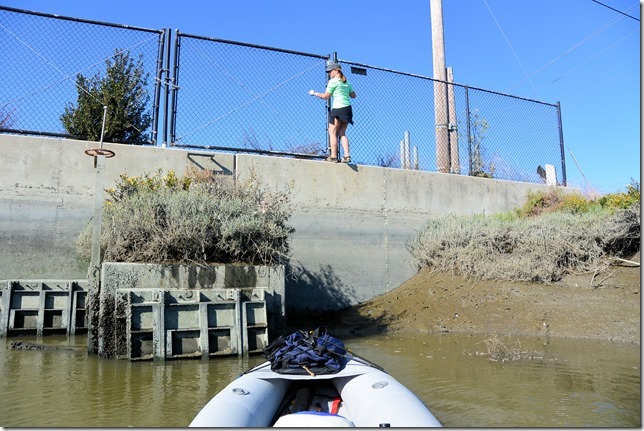
Once Karin got situated atop the concrete, I handed her all the stuff she could toss over the fence, and then we set about hauling the kayak up the muddy slope to the shrubbery at the top edge. What a hero(ine) my gal is. She held onto the bow line while I climbed out the same precarious path, and then we both heaved and hauled our trusty little boat up onto dry land.
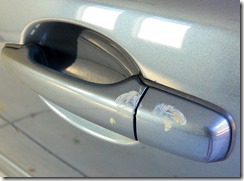 But what a mess. When we got finished, mud was everywhere. The boat, our shoes, our hands and arms, legs, butts, clothes, absolutely EVERYWHERE. As we deflated and loaded up the boat, we tried to keep the car clean – with not a lot of success.
But what a mess. When we got finished, mud was everywhere. The boat, our shoes, our hands and arms, legs, butts, clothes, absolutely EVERYWHERE. As we deflated and loaded up the boat, we tried to keep the car clean – with not a lot of success.
As we got into the car and got ready to head home, Karin looked at me with that very special meaningful look that wives give their husbands when they really mean it. “We are not going out to dinner on the way home”, was all that she said. And she said it meaningfully.
Being a sensitive-husband kind of guy, I felt that it was my duty to comply – so we did a little more exploring instead. We found the old pier at the end of the access road, and a little beach under the highway 84 overpass. Not a big beautiful scene, but we were there and so was this stuff. You can even fish without a license from that pier.
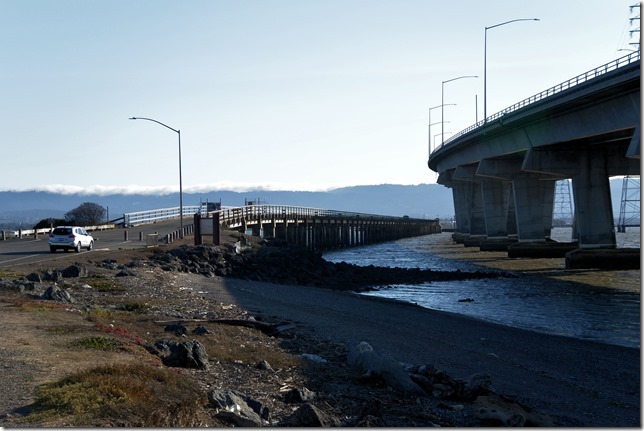
By that time, the rush hour traffic had died off, so we wandered on home. Not an extraordinary place, but still a pretty decent day. Lots of interesting sights and some valuable lessons as well.

I have see this “boat ramp” for years. Is it allowed to kayak on the Newark Slough? I imagine the wildlife refuge doesn’t care as long as you don’t go on shore or put a fishing pole in the water.
Brandon, please see my new blog site…
divvercity.substack.com
and make future comments there.
Sorry, but I don’t have any current info on the slough.
Thanks for reading…
I had the same experience today…strong winds on the way back and a muddy exit.
I would rather get muddy starting off the day (can wash it off while kayaking) so next time should start -3 hours of high tide and finish +2 hours of high tide. Also, did you see the seal colony at the end where the mouth of the slough meets the bay?
Haven’t been there since that one time. Never saw the seals, it’d be great if they were branching inland from the outer coast.
G.